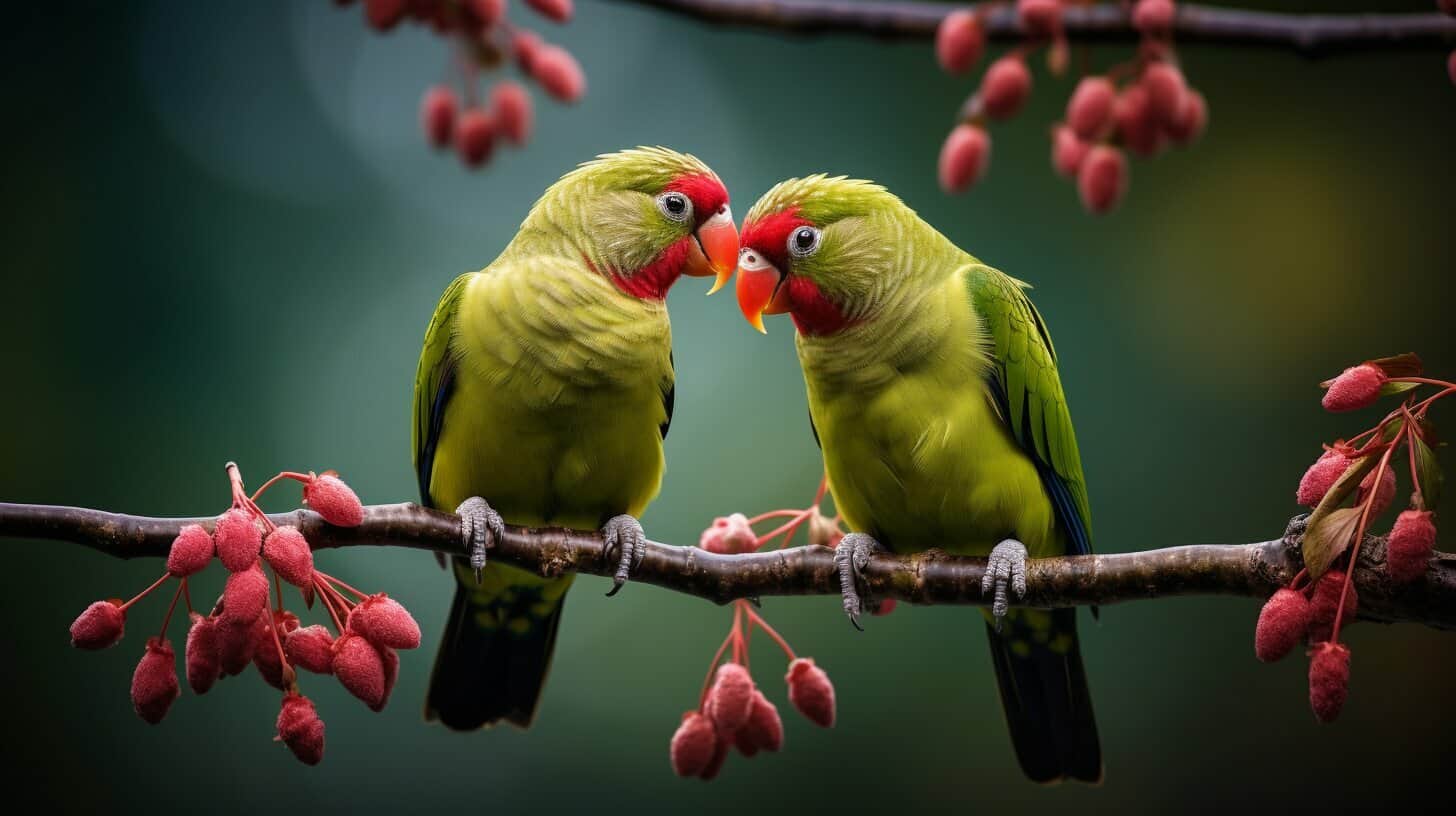Welcome to our guide to breeding kakarikis! Many bird enthusiasts are drawn to these beautiful parrots, but few know how to breed them successfully. In this article, we’ll explore the factors contributing to successful kakariki breeding, from the breeding season and captivity considerations to creating a suitable environment and understanding breeding behaviour. We’ll also provide expert tips and best practises for those interested in breeding kakarikis.
Key Takeaways
- Kakarikis are a vibrant species of small parrots originally from New Zealand.
- To successfully breed kakarikis, it’s important to understand their breeding season and create suitable conditions in captivity.
- A suitable breeding environment includes a spacious cage or aviary, appropriate nesting options, and an active environment.
- Identifying the sex of the birds and pairing them appropriately is essential for successful breeding, as is adhering to best practises throughout the breeding process.
- Providing a proper diet, monitoring breeding pairs, and ensuring the well-being of the chicks are all important tips for successful kakariki breeding.
Understanding Kakarikis: A Vibrant New Zealand Parrot
Kakarikis are a species of small parrot that is native to New Zealand. These birds are known for their vibrant and eye-catching appearance, making them popular among bird enthusiasts.
The scientific name for the kakariki is Cyanoramphus novaezelandiae, meaning “blue-tinged New Zealand parrot.”
Kakarikis are relatively small, with an average length of 26-29cm and a weight of 90-120g. Their plumage is typically green, with variations in shades and patterns depending on the subspecies.
The Breeding Season and Captivity: Factors to Consider
Understanding the breeding season of kakarikis is essential for successful breeding in captivity. In their natural habitat, kakarikis breed during the warm months between September and February, when food and temperatures are ideal. During this time, they form breeding pairs and build nests in tree cavities or logs.
When breeding kakarikis in captivity, it’s crucial to replicate these natural conditions as closely as possible. Providing a spacious cage or aviary with plenty of natural light and fresh air is a good start. You should also ensure that the temperature and humidity levels are suitable for breeding. A temperature of around 20-25°C and a humidity level of 50-70% are ideal for kakarikis.
Another important consideration is the availability of nesting options. In the wild, kakarikis use tree cavities or logs as their nests. In captivity, they will readily use nest boxes filled with suitable bedding material, such as wood shavings or shredded paper. Providing a nest box with an entrance hole of around 6-7cm in diameter and dimensions of around 30x30x40cm is suitable for kakarikis. It’s also important to position the nest box in a quiet and secluded area to avoid disturbance.
During the breeding season, kakarikis become more active and vocal, and males may display courtship behaviours such as feeding or preening their mate. Providing a stimulating environment with plenty of toys, perches, and natural branches can help keep the birds active and engaged and encourage breeding behaviour.
Creating a Suitable Environment for Breeding Kakarikis
Creating a suitable environment for breeding kakarikis is crucial for successful breeding. These active birds require plenty of space and a stimulating environment to encourage breeding behaviour.
When selecting a cage or aviary, ensure it is spacious enough to allow the birds to fly and exercise. A breeding pair should have a minimum size of 50 x 50 x 75 cm. It should also have enough perches, toys and other bird-safe items for stimulation and exercise.
Providing suitable nesting options is also important. A nest box should be placed in a secluded area of the cage or aviary, where the birds can retreat and feel safe. A wooden nest box with a small entrance hole is recommended, as it provides a natural and secure environment for the birds to breed in.
Maintaining a clean and hygienic breeding environment for the kakarikis is essential. Regular cleaning of the cage or aviary, including the nest box, is necessary to prevent the buildup of bacteria and mites.
Kakariki breeding pairs require a nutritious and varied diet to encourage breeding. You can provide them with a balanced diet consisting of fresh fruits and vegetables, seeds, and pellets formulated for small parrots. Calcium supplements such as cuttlebone or eggshells are also recommended to support egg-laying and chick development.
Overall, creating a suitable environment for breeding kakarikis requires careful consideration of their habitat, nesting options, and diet. These factors play critical roles in encouraging breeding behaviour and ensuring the well-being of the birds and their chicks.
Understanding Kakariki Breeding Behaviour and Pairing
Successful breeding of kakarikis depends on knowing their behaviour and appropriately pairing them. First, it is important to determine the sex of each bird. Males tend to be larger with a broader head, while females have rounder heads and smaller beaks. Sexually mature males also have a more pronounced blue crown and rump, while females have a more muted green colour.
It is best to pair birds that are at least 12 months old, as they are more likely to be sexually mature. If possible, observe the birds’ behaviour beforehand to ensure compatibility. Pairing birds of similar size and age is recommended to avoid aggression and improve breeding success.
During the breeding season, males will court females by bobbing their heads and feeding them. Monitoring the pair during their courtship is important to ensure that mating is successful and the female lays eggs. Once the female lays a clutch of eggs, usually 4-7 eggs, the pair will take turns incubating the eggs for around 20-23 days.
After the chicks hatch, it is best to leave them with the parents for at least 3 weeks until they are strong enough to leave the nest. During this time, it is important to provide a suitable diet to the breeding pair to ensure the well-being of the chicks.
By understanding the breeding behaviour of kakarikis and appropriately pairing them, breeders can increase the chances of successful breeding and healthy chicks.
The Breeding Process: From Eggs to Chicks
Once the eggs have been laid, the incubation period for kakarikis is around 20 to 23 days. During this time, it is essential to maintain optimal temperature and humidity levels in the breeding environment to facilitate healthy development.
After the chicks hatch, they will be blind and featherless. They will rely on their parents for warmth and food, and providing them with a well-balanced diet is crucial to ensuring proper growth. Kakarikis chicks will begin to develop feathers at around two weeks old and will start to explore their breeding environment.
It is essential to monitor the chicks’ progress during this time and ensure they receive enough food and attention from their parents. After around five to six weeks, the chicks should be ready to fly and leave the nest box. However, providing them with a secure and stimulating environment to continue their development is still crucial.
Tips for Successful Kakariki Breeding
Breeding kakarikis can be a rewarding and enjoyable experience. It is important to follow expert tips and guidelines to ensure successful breeding. Here are some tips to help you with your kakariki breeding journey:
- Provide a balanced and nutritious diet – Feeding your birds a balanced and nutritious diet is crucial for successful breeding. Ensure their diet includes fresh fruits, vegetables, grains, and a good quality pellet or seed mix. Consider adding calcium and vitamin supplements to their diet, especially during the breeding season.
- Create a suitable environment – Providing an optimal environment is essential for breeding kakarikis. They require a spacious cage or aviary with plenty of room to fly and play. Giving them access to a nest box or other suitable nesting options is also important. Maintaining an active and stimulating environment will keep the birds healthy and happy.
- Monitor breeding pairs – It is important to pay close attention to your breeding pairs. Observe their behaviour and ensure that they are mating and nesting correctly. Keep an eye out for any signs of aggression or illness.
- Identify the sex of your birds – Knowing the sex of your birds is crucial for successful breeding. The easiest way to do this is to visually sex them by observing their physical characteristics and behaviours. Alternatively, you can have them DNA sexed.
- Pair birds correctly – Pairing your birds correctly is important for successful breeding. Ensure the birds you pair have compatible personalities and are of breeding age. Avoid pairing closely related birds to reduce the risk of genetic issues.
- Monitor and care for chicks – Once they have hatched, it is important to properly monitor and care for them. Ensure they have access to supplementary food and water and are kept warm and cosy. Keep the nest clean to prevent any infections.
- Be patient – Breeding kakarikis can take time, and patience is important. It may take several attempts before a pair successfully breeds. Take your time and enjoy the process.
Following these tips can increase your chances of successful kakariki breeding. Always provide appropriate care and attention to your birds, and seek expert advice if you encounter any issues.
Conclusion
Successful breeding of kakarikis requires a combination of understanding their natural behaviour and providing suitable breeding conditions. By replicating their natural breeding season, creating an active and spacious environment, and pairing the birds appropriately, breeders can increase their chances of success.
Breeders must monitor their breeding pairs and provide a balanced diet with calcium supplements. Ensuring the well-being of the chicks requires adequate care and attention, including regular health checks.
By following the tips and guidelines outlined in this article, breeders can increase their chances of successful kakariki breeding. Always seek expert advice and continually educate yourself on the best practises for breeding these vibrant New Zealand parrots.
FAQ
Q: Are kakarikis easy to breed?
A: Breeding kakarikis can be a rewarding experience, but it does require knowledge and preparation. Understanding their breeding behaviour and providing a suitable environment are key factors for successful breeding.
Q: What is the breeding season for kakarikis?
A: Kakarikis usually breed during the warmer months, typically from spring to early summer. It is important to replicate these natural conditions in captivity to encourage breeding.
Q: How do I create a suitable environment for breeding kakarikis?
A: To create a suitable breeding environment, provide a spacious cage or aviary with appropriate nesting options such as nest boxes. Maintaining an active and stimulating environment for the birds is also important.
Q: What should I consider when pairing kakarikis for breeding?
A: When pairing kakarikis for breeding, it is important to identify the sex of the birds and pair them appropriately. An ideal pairing consists of a mature male and female kakariki.
Q: How long does the breeding process take?
A: The breeding process usually starts with forming a clutch of eggs. Incubation typically lasts around 21 to 24 days, and the chicks will hatch after this period. Before the chicks become independent, the breeding pair will care for them for a few weeks.
Q: What are some tips for successful kakariki breeding?
A: Some tips for successful kakariki breeding include providing a balanced and nutritious diet, offering calcium supplements for egg development, closely monitoring breeding pairs for any signs of stress or health issues, and ensuring the chicks are well-cared for and provided with a suitable environment.



Have comments or questions about this article? Then get involved!
Spotted an error or something we have missed? Let us know